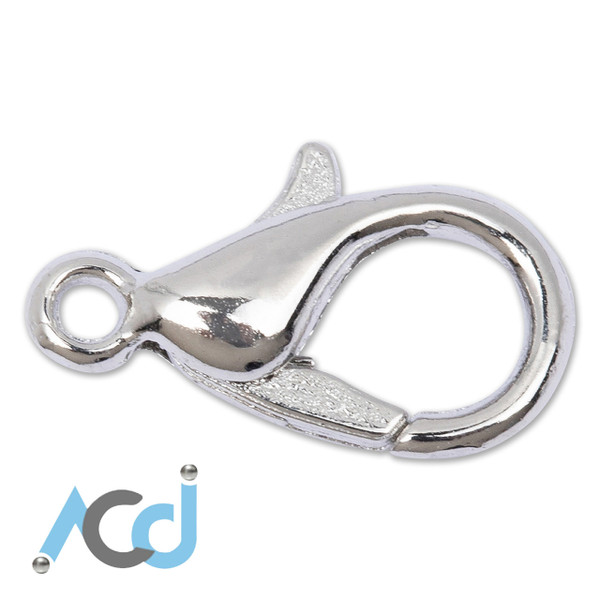Interesting Things About Lobster Clasps You Should Not Miss
22nd Sep 2020
To finish making pieces of jewellery such as necklaces and bracelets, you need to attach or fasten the chains. And the tool that makes all the magic is the clasp! However, just like pieces of jewellery, clasps come in many different designs. Some are easier and more convenient to work with, while others are elaborate and complicated.
One of the commonly used clasps today is the lobster clasp. Jewellery makers prefer to use it and buy wholesale lobster clasp because of its ease of operation. If you want to get to know more about this renowned clasp, we have outlined in this article some interesting things you might enjoy reading.
What is a lobster clasp?
Lobster catches, or more commonly known as lobster clasps, are among the various types of mechanisms used to fasten necklaces and bracelets. They are considered to be the next step up from a bolt ring and have a resemblance to lobster claws. A lobster clasp is stronger, heavier, and more expensive than a bolt ring, which makes it an ideal choice for high-end jewellery items.
Because of its features, a lobster clasp is suitable for a longer length and heavier pendant. It also helps keep bracelet chains with the weight of the chain or pendant that offsets the clasp in position. On the contrary, the lobster clasp is not suited to lightweight chains.
When you use lobster clasp as a fastener, be sure to consider the size of the ring you need to secure within the clasp. Make sure that the trigger does not open inwards to avoid restriction of functionality. The size of the lobster clasps starts at 7mm and goes up to a substantial 18mm.
How did lobster clasp earn its name?
In 1970, the lobster claw clasp made its first appearance on the jewellery scene, which explains why it is more commonly found on Retro bracelets and necklaces. This type of jewellery closure is named after the ocean crustacean claw that occurs in nature. It has an obvious resemblance of a lobster’s claw and trigger movement (a pinching mechanism).
The user can easily operate the clasp by pinching the protruding lever on the back. This step of the process will trigger an internal steel spring, therefore opening the jaws on the opposite side of the component. You may grab a jump ring or chain link to create a connection point. When designing a piece of jewellery, you should not forget to consider the costs involved.
How does a lobster clasp work?
To open and close the lobster clasp, hold the small lever, usually with a fingernail, long enough to execute the action you want to complete. Use this mechanism to attach to or remove from a short link-chain or a ring-like structure. You can also use it when finishing up necklaces, bracelets, and keyrings.
Which is better between the lobster clasp and spring-ring clasp?
Lobster clasps are usually compared to spring-ring clasps. The reason for that is because they are both safe and cost-effective clasps that do not overpower the jewellery pieces. So, which among the two is better? Which of them is ideal for scaling jewellery designs to larger or smaller beads?
The Spring-Ring Clasp
This type of jewellery clasp dates back in the heyday of the Victorian jewellery era. In the early 1900s, spring-ring clasps were found on antique bracelets.
As the name implies, a spring-ring clasp is circular or ring-shaped that has a small nub poking out of it. To operate this tiny piece of jewellery closure, you need to pull it back to open the ring to allow the hook on the other end of the jewellery (bracelet or necklace) to slip inside. When you release the lever, the spring inside the ring automatically closes the gap.
The Lobster Claw Clasp
This type of jewellery clasp is the more modern variation on the spring-ring clasp. It got its name from its Crustacean shape and the pinching motion of its fastener. Similar to the spring-ring clasp, you can lever back and forth a small nub poking out of the lobster claw end to attach to a ring on the other end of the jewellery piece.
Lobster claw claps are more commonly found on Retro bracelets and necklaces. The reason for that is because they appeared on the jewellery scene in the 1970s. Today, this fastener has already a variation—the swivel clasp. This modern type of jewellery clasp is capable of rotating in a complete circle at its base.
Compared to a spring-ring clasp, a lobster claw clasp is a little stronger and sturdier. That’s because the mechanism is made out of a thicker piece of metal. By pressing down on the lever, the bottom part moves inside. Then it leaves behind a space for the other end of the chain.
Repairing a lobster clasp is not as common as the spring ring repair because the little bottom part is prone to be pried out from wear. The jeweller can use a pair of pliers to bend it back into shape. However, the lever may get stuck on occasion, and the repair for that kind of damage is variable. So, when jewellers cannot fix it, they will require you to replace it.
While lobster clasps are not as dainty as spring-ring clasps, they are suitable for heavier chains, bigger necklaces, or necklaces with pendants since their components can support the weight.
There is really no definite answer to the question about which of the two is better. It all comes down to who will use it, what type of chain will it be used, and what size of clasp the jewellery maker will need.
Where can you buy wholesale lobster clasps?
When you buy lobster claw clasps, you can choose from a variety of shapes and sizes. You can select the piece that closely matches the rest of your design, such as oval or trigger lobster claws, standard lobster clasps, and fancy-shaped lobster clasps.
If you are looking to purchase lobster clasps and you want to save money, you should opt for wholesale lobster clasps. At Aussie Chains Direct, we allow large-scale lobster clasps purchases to help loyal customers save. If happen to be a reseller, you should not miss this chance!
Visit our website https://aussiechainsdirect.com.au/ to see complete product specifications for each of the jewellery closures we sell.

